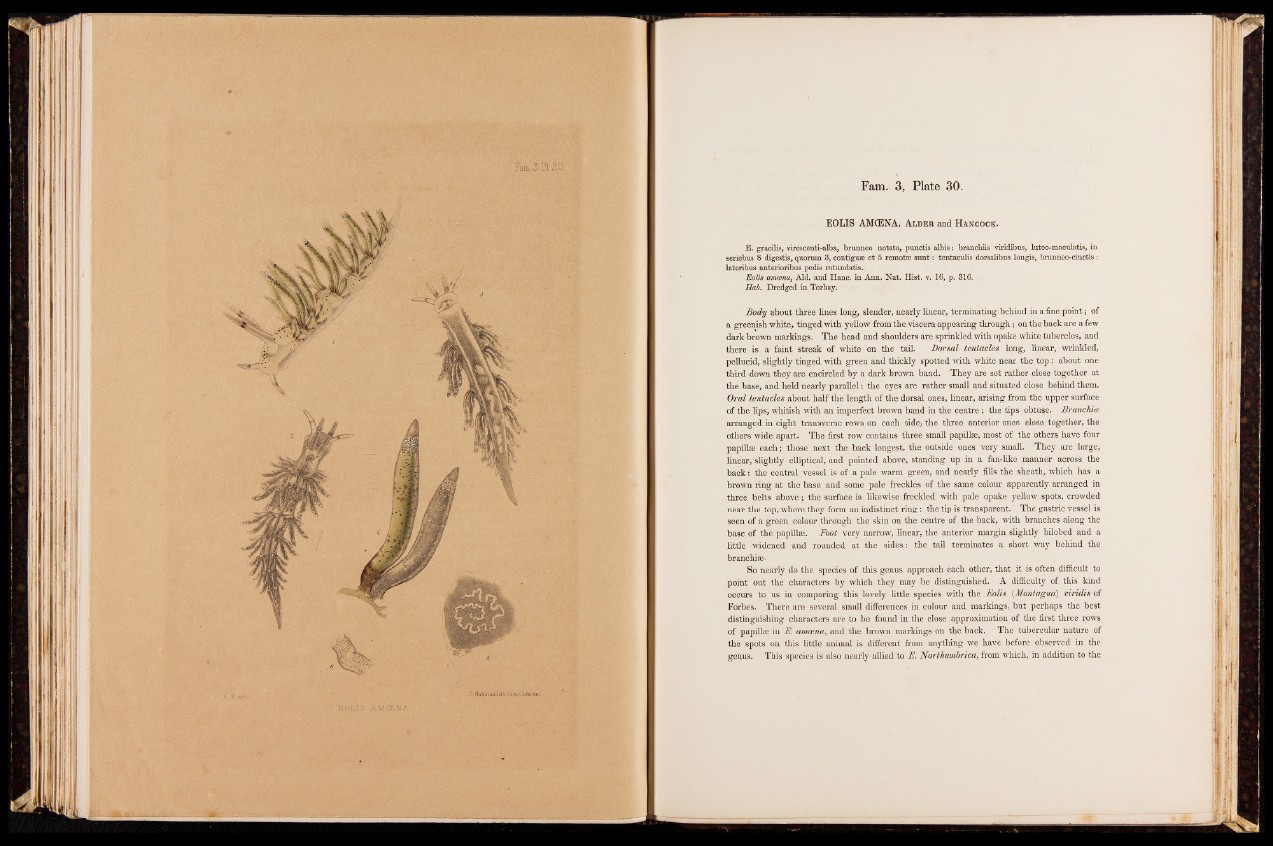
Seifs; am:« S a,,'
Fam. 3, Plate 30.
EOLIS AMCENA, Aldeb and Hancock.
E. gracilis, virescenti-alba, brunneo notata, punctis albis: branchiis viridibus, luteo-maculatis, in
seriebus 8 digestis, quorum 3, contiguse et 5 remotse su n t: tentaculis dorsalibus longis, brunneo-cinctis :
lateribus anterioribus pedis rotundatis.
Eolis amoena, Aid. and Hanc. in Ann. Nat. Hist. v. 16, p. 316.
Hab. Dredged in Torbay.
Body about three lines long, slender, nearly linear, terminating behind in a fine point; of
a greenish white, tinged with yellow from the viscera appearing through; on the back are a few
dark brown markings. The head and shoulders are sprinkled with opake white tubercles, and
there is a faint streak of white on the tail. Dorsal tentacles long, linear, wrinkled,
pellucid, slightly tinged with green and thickly spotted with white near the top : about one
third down they are encircled by a dark brown band. They are set rather close together at
the base, and held nearly parallel: the eyes are rather small and situated close behind them.
Oral tentacles about half the length of the dorsal ones, linear, arising from the upper surface
of the lips, whitish with an imperfect brown band in the centre; the tips obtuse. Branchia
arranged in eight transverse rows on each side, the three anterior ones close together, the
others wide apart. The first row contains three small papillae, most of the others have four
papillae each; those next the back longest, the outside ones very small. They are large,
linear, slightly elliptical, and pointed above, standing up in a fan-like manner across the
back: the central vessel is of a pale warm green, and nearly fills the sheath, which has a
brown ring at the base and some pale freckles of the same colour apparently arranged in
three belts above; the surface is likewise freckled with pale opake yellow spots, crowded
near the top, where they form an indistinct ring: the tip is transparent. The gastric vessel is
seen of a green colour through the skin on the centre of the back, with branches along the
base of the papillae. Foot very narrow, linear, the anterior margin slightly bilobed and a
little widened and rounded at the sides: the tail terminates a short way behind the
branchiae.
So nearly do the species of this genus approach each other, that it is often difficult to
point out the characters by which they may be distinguished. A difficulty of this kind
occurs to us in comparing this lovely little species with the Eolis (Montagna) viridis of
Forbes. There are several small differences in colour and markings, but perhaps the best
distinguishing characters are to be found in the close approximation of the first three rows
of papillae in E. amoena, and the brown markings on the back. The tubercular nature of
the spots on this little animal is different from anything we have before observed in the
genus. This species is also nearly allied to E. Northumbrica, from which, in addition to the